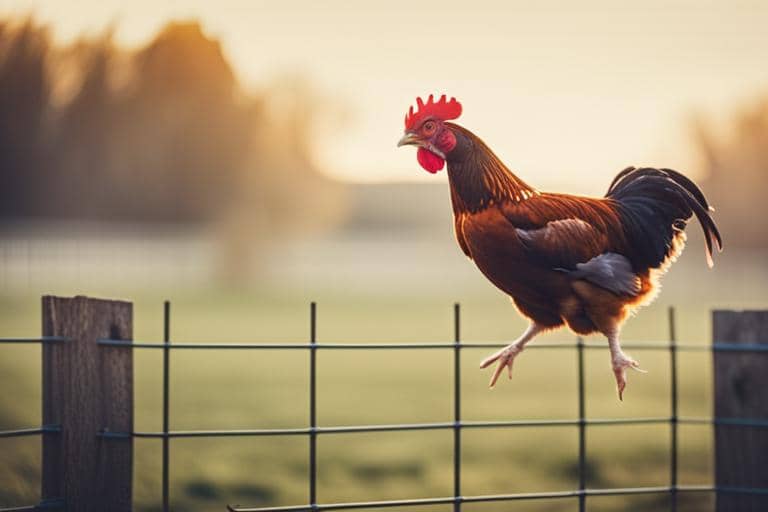Can Chickens Fly? A Comprehensive Guide to Their Anatomy and Flight Capabilities
Chickens are fascinating creatures that have captured the hearts of many people. If you’re an animal lover, it’s natural to wonder, “can chickens fly?” The answer is yes, but their flight capabilities are limited. Chickens have been domesticated for thousands of years and are a staple in the poultry industry. Backyard chicken-keeping has also become increasingly popular. In this comprehensive guide, we will explore the anatomy of chickens, their flight capabilities, and the factors that affect their ability to fly.
Chicken Anatomy
Chickens have a wingspan of around 30-36 inches and weigh between 3-8 pounds. Their bone structure is light and hollow, which allows for easier movement. Chickens have strong chest muscles that power their wings and help them to fly.
Can Chickens Fly?
This article is a comprehensive guide to understanding the anatomy and flight capabilities of chickens.
– Physical characteristics, flight types, and factors affecting chickens’ ability to fly are discussed.
– The maximum height and distance chickens can fly, the importance of flight for chickens, and domesticated chickens’ flight capabilities are also covered.

Understanding Different Types of Flight
In the animal kingdom, there are two types of flight: powered and gliding. Chickens are capable of powered flight, which means they use their own energy to stay in the air. However, they are not known for their ability to fly long distances or high altitudes. They are capable of flying a few feet off the ground for short distances, with the maximum distance being approximately 50-60 feet. The maximum height a chicken can fly is about 10 feet.
Factors Affecting a Chicken’s Ability to Fly
Several biological and environmental factors affect a chicken’s ability to fly. The age, weight, and overall health of a chicken can affect its flight capabilities. Environmental factors such as temperature, humidity, and altitude can also affect a chicken’s ability to fly. Additionally, selective breeding has had an impact on the flight capabilities of domesticated chickens.

Importance of Flight for Chickens
In the wild, chickens use flight as a means of escape from predators, to find food, and to navigate their environment. Flight is an essential survival mechanism for chickens in the wild. However, domesticated chickens have less of a need for flight as they are protected from predators and provided with food and shelter.
Domesticated Chickens and Flight
Selective breeding has significantly impacted the flight capabilities of domesticated chickens. Many breeds of chickens have been selectively bred for their meat or egg production, which has resulted in a decrease in their ability to fly. Additionally, many backyard chicken coops do not provide enough space for chickens to fly.
As a chicken owner, I have noticed that my chickens are capable of short flights but prefer to spend their time on the ground. However, providing a suitable environment for chickens to fly can improve their flight capabilities. Giving them access to a large run or free-ranging can help them to develop their flight muscles.

Can Chickens Learn to Fly?
Chickens have the capacity to learn to fly. However, training a chicken to fly takes time and patience. The training process involves teaching the chicken to flap its wings and jump. Over time, the chicken will develop the muscles needed for flight. Specific exercises include placing the chicken on a low perch and encouraging it to jump down or tossing mealworms in the air to encourage the chickens to jump and flap their wings. Training a chicken to fly can be a fun activity for backyard chicken keepers.
Personal Story: The Importance of Flight for Chickens
I grew up on a small farm with a flock of free-ranging chickens. My family always made sure the chickens had plenty of space to run, jump, and fly. I remember one day, while collecting eggs, I noticed one of our hens was missing. After a few minutes of searching, I found her perched on a tree branch about 8 feet off the ground. I was amazed that such a heavy bird could fly so high!
Later, I learned that chickens use flight to escape predators, find food, and navigate their environment. Our chickens were able to roam freely, and their ability to fly gave them an advantage in avoiding potential danger. By providing them with enough space to fly, we were giving them the opportunity to live a more natural and fulfilling life.
This personal experience taught me the importance of flight for chickens, and how it can affect their overall wellbeing. Chickens that are confined to small spaces without the ability to fly may suffer from boredom, stress, and health issues. As animal caretakers, it’s our responsibility to provide chickens with the space and resources they need to fully express their natural behaviors, including flight.

Ethical Considerations of Selective Breeding
Selective breeding has raised ethical concerns regarding animal welfare and biodiversity. The flight capabilities of chickens have been significantly impacted by selective breeding for meat and egg production. This has led to a decline in biodiversity, as many breeds of chickens are no longer able to fly or exhibit other natural behaviors. It is important for chicken keepers to consider the ethics of selective breeding and ensure that their chickens have access to an environment that allows them to express natural behaviors.
| Type of Movement | Description |
|---|---|
| Running | Chickens primarily move by running. They can run up to 9 miles per hour. |
| Jumping | Chickens are capable of jumping up to 3 feet in the air. |
| Flying | Chickens are capable of short, powered flights up to a maximum distance of approximately 50-60 feet and a maximum height of about 10 feet. |
Other Ways Chickens Move
In addition to flying, chickens have other means of movement. Chickens can run, walk, and jump. Running is their primary means of movement, and they are capable of running up to 9 miles per hour. Jumping is another way chickens move, and they can jump up to 3 feet in the air.
Conclusion
In conclusion, chickens are capable of short, powered flights, but their flight capabilities have been significantly impacted by selective breeding. While flight may not be essential for domesticated chickens, it is an important survival mechanism for wild chickens. Providing a suitable environment for chickens to fly can improve their flight capabilities. Chickens can also learn to fly with patience and training. Chickens have other means of movement, including running and jumping, and it’s important to ensure these needs are met as well. As chicken keepers, it is our responsibility to consider the ethical implications of selective breeding and ensure that our chickens have access to an environment that allows them to express natural behaviors.
Questions and Answers
Q. Who can fly, roosters or hens?
A. Both male and female chickens can fly short distances.
Q. What makes chickens able to fly?
A. Their wings are designed for short flights and gliding.
Q. How high can chickens fly?
A. Chickens can fly up to 10 feet in the air for short distances.
Q. Can all breeds of chickens fly?
A. Most breeds can fly short distances, but some heavier breeds may struggle.
Q. What if my chickens won’t fly?
A. Some chickens may not fly due to age, health, or temperament.
Q. Aren’t chickens flightless birds?
A. While they cannot sustain long flights, chickens are not considered flightless.




Leave a Reply